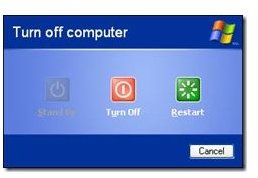Why is My System Standby Button in XP Grayed Out?
System Standby
To start off, let’s go over what system standby is and what it does. After all, it never hurts to learn something new or refresh your memory.
In a nutshell, system standby puts the computer to sleep. It is still alive, but not doing very much. Electricity usage slows to a trickle, monitors and other hardware gets turned off or switched to a standby mode, and anything you were doing gets saved to short term memory. Then, when you need to get back into the computer, the system will wake up and be up and running in a fraction of the time it would take to turn on. However, this great ability does come with some unexpected downfalls.
When system standby is used on a laptop, you must be sure that you will have enough energy to keep it sleeping; if it were to run out of electricity, any data that was being saved in memory will be lost since the data is saved in volatile memory. Volatile memory only holds onto data when there is energy keeping it running. Take away the juice and you can say goodbye to your data. If used correctly, that is for shorter period of non use, system standby is a great tool.
Why is StandBy Grayed Out?
Your Computer is Not Broken
You go to put your computer into standby mode and the button is grayed out and not click-able. What do you do? What happened? How do I fix it? All valid questions but the first step is to not panic. This does not necessarily mean you have a virus or that your computer is broken.
Is it Enabled?
First you should check that you have system standby enabled. To do this, right click on your desktop and click “Properties,” then click on the “Screen Saver” tab. Now click the “Power” button near the bottom and when the new window opens, make sure that the drop-down boxes next to “System Standby” do not say “Never.” If they don’t say “Never” and it is in fact turned on, we do what we know to be tried and true. Update.
Either find the Windows Update shortcut in your Control Panel window or point Internet Explorer to https://update.microsoft.com. From there, Windows Update will make sure that your Operating system and other Windows components are up to date. This also may not solve the problem, but at least have an updated computer which will solve and prevent problems in the future.
That Didn’t Work? Keep Trying…
Those Darn Drivers…
This problem does seem to have a common solution: drivers, specifically graphic drivers. The best thing to do is to like we did before with Windows, update your drivers. This is not a very enjoyable process, but it can help. However, with many PCs, your drivers are also updated when you run Windows Update. Amazing right? If yours did not update the drivers, head on over to the manufacturer’s website to obtain the updated versions of your drivers.
If updating them does not work or there are no updates, you should try rolling back. This process just downgrades the version of your drivers which may return the computer to a state where standby is usable again. When doing this, you should keep track of what is going on so that you can discover the origin of the problem. Once you know what is causing all the problems you may be able to find a better solution.
Furthermore, make sure you have standard VGA drivers installed on your system. Far too many people who do a clean install of XP have their standby unusable because of this. Either install the standard VGA drivers that Microsoft offers or the ones from your motherboard CD.
Still Not Working?
One possible problem is your computer may just be too old! The problem lies in the motherboard chip set. The motherboard has to have Advanced Configuration and Power Interface [ACPI] / Power Management features. If not, then you will not be able to utilize the standby feature. This should be a rare problem as most computers have these features.
If the above tips have not fixed your problem there could be something else amiss with your computer. Your peripherals (keyboard and mouse) may have mucked things up. If you believe that this is your problem, simply connect the original keyboard and mouse and see if the situation has been fixed.
If all else fails and you still are having this problem, you will need to contact some kind of support. Call your manufacturer, send them an e-mail; just get in contact with them. They will have more information and ideas that are specific to your computer that you should try.
